Abstract
Cleaner production (CP) has emerged as a new concept to cope with the astronomical environmental degradation associated with the expanding scope of industrialization. We conducted a review of the scientific data on the conceptualization of “cleaner production” using published documents from the 2011–2021 period. Data were extracted from the CNKI and WOS databases—two major databases based in China and the United States, respectively. Citespace software was used to track the developmental process and trend of future research on cleaner production. We report the following findings: (1) While the literature on cleaner production in CNKI is decreasing, the literature in WOS has been increasing annually. (2) Even though clear instances of different research priorities exist between WOS and CNKI, the research problems addressed in the two databases, however, are mostly common. In terms of research collaboration, WOS is more likely to accept papers with cross-institutional authorship. The study further identified that there is no aggregation effect between Chinese research institutions. (3) In WOS, the Journal of Cleaner Production is the most popular journal for researchers, and in CNKI the Chinese Journal of Agricultural Resources and Regional Planning leads in CP publications. (4) Regarding the research hotspots, there are obvious differences between WOS and CNKI. Finally, we put forward the future prospects for cleaner production research.
1. Introduction
The increasing industrial activities have subjected the natural environment to serious damage in diverse ways [1,2]. As a result, several sustainable development models are being proposed to engender green production. Political administrators are particularly under pressure from international non-governmental organizations (INGOs) to prioritize environmental issues [3]. Against this backdrop, many countries have formulated policies such as environmental legislation, pollution emission standards and cleaner production (CP) strategies to mitigate the undesirable industrial impacts on the environment. The 2030 Agenda proposed by the UNEP (2015) lists 17 sustainable development goals and 169 specific goals [4].
Research has shown that the sole reliance on terminal treatment to solve environmental problems has failed [5,6]. Cleaner production, therefore, was conceived as a new concept for overall pollution prevention and was first introduced in the chemical industry [7]. With many years of growing popularity, it has been introduced in other industrial sectors, including agricultural and manufacturing. In practice, it is believed that CP plays an important role in resource conservation, efficiency improvements and pollution emissions reductions [5]. Cleaner production is conducive to achieving the sustainable development goals [4]. It is, therefore, touted as an important way to achieving sustainable development.
Presently, there is no unified definition of CP. Most scholars classified it as a scheme for pollution prevention, clean technology, energy savings and emission reductions [8]. Since the industrial advancements vary between countries, the United Nations Environment Programme (UNEP) tried to propose a standard definition of CP in 1996 as “a kind of systematic, sustainable and innovative thinking mode which runs through the environmental protection strategy in all aspects of management, production and services, and reduces environmental damage caused by economic production” [9]. European countries call it a “less waste and no cost process” [10]. Since this proposition, different countries have summarized it in different but complimentary ways. For instance, Japan mostly sees it as a “pollution-free process”. The US refers to it as “pollution prevention” and “waste minimization”, among others. Cleaner production is a way of thinking with integrity, sustainability and innovation. This ideology applies to environmental protection strategies in all aspects of production, management and service [5]. The concept of cleaner production was expanded at the Fifth High-Level Seminar on Environmental Sustainability organized by the UNEP, whereby industrial ecology was included within the scope of CP [9].
In terms of management, cleaner production is seen as incorporating environmental factors into daily management. From a production process perspective, this is mainly reflected by using environmentally friendly, energy-saving and non-toxic materials to reduce pollution [11]. Relative to product design, the drive to reduce the impacts on the environment after product abandonment relieves the burden of fatal environmental consequences [12].
In essence, cleaner production encapsulates the production methods that reduce adverse environmental impacts from human economic endeavors, thereby resulting in efficient resource utilization [12,13]. CP can be achieved through specific measures such as improving technology and management processes, streamlining production processes and reducing pollution emissions from products or services [5]. Since CP is a universal, scientific and environmental method, it has become an important way to achieve sustainable development in the future. The core factors of CP include green production, low-carbon production, lean production and circular production [12]. However, there are many obstacles preventing the adoption of cleaner production. For example, Leite [14] pointed out that cultural and technological barriers have a negative impact on the adoption of cleaner production by small enterprises. The scale of the company affects the level of enterprise adoption and the implementation of cleaner production [15]. We should pay attention to these barriers and overcome them for better implementation results.
The significance of CP can be summarized by three core aspects. First, CP involves pollutant prevention and control from the source. CP is not only concerned with the production process, but all stages of product production. It strives to reduce pollutants at the source and improves the efficient use of resources, rather than the traditional end treatment [12]. Second, CP is designed to change the mode of economic development. Specifically, it adopts a more intensive production model differing from the traditional extensive development model [5,16]. Third, CP can help achieve sustainable development. The use of a clean production process is key to improving the level of production and management to enhance the benefits and environmental benefits [10].
The UNEP first proposed the term “cleaner production” in 1989. After this, the UNEP formulated the ‘Cleaner Production Plan’. Since the birth of the CP concept, scholars have carried out continuous and detailed research on clean production mechanisms. The US Congress passed the Pollution Prevention Act in 1990, which clearly announced that the pollution prevention policy would replace the long-term pollution control policy focusing on “end treatment”. In 2019, the UNEP recommended that CP should be taken as a development strategy [17]. They further recommended that its ideas should be integrated into all stages of production and management, including the minimization of environmental pollution. China promulgated its law on Cleaner Production Promotion in 2002. In principle, the law seeks to make effective use of every resource, and at the same time to reduce or even avoid the generation of pollutants in the production process so as to achieve the goal of protecting the natural environment.
There are many studies on CP, including studies related to the legal system, standards, development process, technology and management [9]. However, at present, there are no empirical studies on the evolution of CP and its development. It is, therefore, necessary for a study to be conducted on CP to bring to bear the distribution of publications on the subject matter, while contributing knowledge to shape the future research direction [9]. Some scholars have used visual means to summarize the progress in specific fields, including ecological environment. Chen et al. [18] conducted a comprehensive bibliometric analysis on biodiesel production from edible waste oil. The authors used ArcGIS 10.2, VOS viewer and Citespace to analyze 2750 publications in the science network’s core collection database (2000–2020). Their study provided a summary of the progress in the field, including the publishing trends, geographical distribution, a CO citation reference analysis and so on. Moreover, Azam et al. [19] researched wind power generation and visually presented the research process and future research development direction. The authors discussed the influence of the economy and technology on traditional wind farms. They further determined the countries and journals with the largest literature outputs. Zhong et al. [20] systematically reviewed the literature on carbon footprint calculations via life cycle assessments and established a knowledge map of the relevant research. Hu et al. [21] analyzed 2099 references from WOS (1968–2018). Their findings established the hot spots, frontiers and developmental trends for the use of the ecosystem model.
The absence of a bibliometric study on cleaner production in the prior literature suggests an urgent need for one to be carried out to address this gap [9]. In the face of many studies on CP, it is imperative to empirically understand the statistics for such publications; in other words, it is important to find out the general characteristics, important fields, most influential scholars, overall characteristics of the literature, research highlights and future research directions of CP.
This thesis analyzes the research results for cleaner production for the period of 2011 to 2021. This was intended to highlight the development and status of cleaner production initiatives and to provide a reference for relevant research. By analyzing the quantity of documents, high-frequency keywords and research hotspots of CP, this paper identifies the similarities and differences between the international and Chinese research. It subsequently defines the evolution process for cleaner production research. On this basis, the future prospects of CP research are put forward.
The remainder of this paper is organized as follows. Section 2 presents the data extraction method. Section 3 and Section 4 focus on the discussion of the literature from WOS and CNKI. Section 5 compares the analysis results from the two databases. Finally, in Section 6 and Section 7, we discuss the findings and subsequently provide a conclusion to the study.
2. Data
2.1. Data Sources
The data for this study were obtained from CNKI and WOS. Compared with other databases, these two databases have more studies and comprehensive coverage, and are recognized as important databases by scholars. In China, CNKI is the most authoritative database. In hard science, WOS is the preferred platform for researchers to publish papers. In CNKI, keywords such as “cleaner production”, “green production”, “lean production”, “low-carbon production” and “recycling production” were used to obtain the needed documents for the study. Since 2011, cleaner production has entered a new stage. China, Brazil, India and other countries have designated key industries for CP and implemented it into key enterprises. A time span of 2011–2021 was used for our data extraction. Overall, a total of 1976 articles were retrieved. Data from international journals were obtained from the Science Citation Index Expanded, Social Science Citation Index and other archives in the Web of Science core database. Moreover, search terms were used to conduct an advanced search in the core collection of Web of Science. These included: (TS = (“cleaner production”) OR TS = (“lean production”) OR TS = (“low-carbon production”) OR TS = (“recycling production”) OR TS = (“greener production”)). A total of 4328 articles were retrieved to that effect.
2.2. Data Processing
This paper analyzed the retrieved data by using the information visualization software CiteSpace developed by Professor Chen Chaomei. Through the visualization of information, we can intuitively understand past and current research hotspots, future research trends and hot research fields within a discipline [22]. Our study adopted the WOS text data format. The document data from CNKI and WOS were preprocessed through the built-in data converter in CiteSpace. After the format conversion, the duplication of WOS and CNKI data ensured the accuracy of the results. Furthermore, in this study, we used the CiteSpace software to analyze the co-words of cleaner production research keywords to master the research status in the field of cleaner production.
3. Analysis of WOS Results
3.1. Overview of Cleaner Production Studies from WOS
Figure 1 shows that from 2011 to 2021, the number of publications increased gradually. It reached its peak in 2020. During the period from 2011 to 2014, not many research activities took place in this field and less documents were published. After 2014, the field attracted a great deal of attention, and accordingly the literature on CP in WOS surged rapidly. From 2017 to 2020, the number of documents gradually increased from 355 to 824. The annual growth rate was 31.4%. As of October, 756 international studies on CP were published in 2021, and this number is expected to upsurge astronomically in the future.
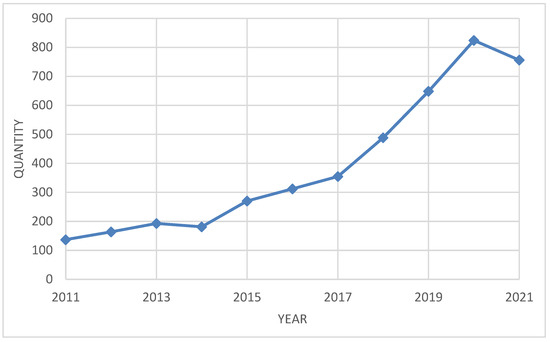
Figure 1.
The quantity of published studies on cleaner production.
Table 1 lists the cleaner production subject areas addressed in WOS. Among the 4328 documents published, 2493 came from environmental sciences and 2190 came from environmental sciences ecology. Moreover, 1926 came from sciences technology and other topics, accounting for 44.5%. These disciplines were the important research fields in WOS. Chemistry, agriculture, energy and fuel, materials science, operations research and management science were also vital subjects in CP research.

Table 1.
Topic distribution of studies on cleaner production from WOS (Top 10).
Table 2 presents an analysis of the literature including co-citations. By combing the five most highly cited studies, we found that the research focused on two aspects, namely the improvement of the utilization of resources to achieve CP and the efficient utilization of resources. For example, Hens et al. [1] connected the SO50001 criterion with an energy management method to address the problem of power consumption in a lead-acid battery factory. On the other hand, they provided a reference and guidance for CP through the perfect theory system framework. Ghisellini et al. [23] reviewed the literature on the circular economy and highlighted the dominant viewpoints. The most central paper was Cleaner Production in Small Firms taking part in Mexico’s Sustainable Supplier Program (centrality = 0.08).

Table 2.
Top 10 most highly cited studies on cleaner production from WOS.
3.2. Quantitative Analysis of the Studies from WOS
3.2.1. Research Institutions
Table 3 lists the research institutions with high publication frequency rates. Most of the top ten institutions happened to be Chinese institutions. The CAS ranks first in terms of its quantity and centrality. This means that Chinese research institutions have contributed significantly to advancing the knowledge on cleaner production. Furthermore, the centrality scores for the Chinese Academy of Sciences reached 0.11. These research results have been referenced by scholars from all over the world. However, the centrality scores for other Chinese institutions are low, mostly at 0.01 or 0.02. This indicates that there is lack of cooperation among these institutions. Consequently, academic exchanges and cooperation across institutions and regions still need to be improved.

Table 3.
Top 10 institutions for frequently published studies on cleaner production in WOS.
3.2.2. Research Hotspots
Table 4 presents the top 10 high-frequency keywords related to cleaner production. Based on this, we can determine that the studies published on CP in WOS for the past decade mainly focused on two aspects, namely the practice of CP and its impact.

Table 4.
Top 10 keywords related to cleaner production in WOS.
Figure 2 shows the top 10 keywords, reflecting the research trends to a certain extent. Adsorption, behavior and biomass were research hotspots in the most recent two years, with salience intensity values of 12.42, 11.31 and 11.11, respectively. This may be related to the United Nations initiative for green economic recovery. This initiative calls on all parties to promote clean and green development against a timetable of “carbon neutrality” put forward by many countries. In this paper, the keywords are clustered. We used the “LLR” algorithm to extract the cluster labels, as indicated in Figure 3. After the cluster analysis on the keywords of 4328 publications in WOS from 2011 to 2021, six (6) main clusters were generated. Table 5 lists the high-frequency terms within each cluster. It was found that the current hot keywords in the field of CP are lean production, energy efficiency, aqueous solution, work organization, operational performance and evaluation method.
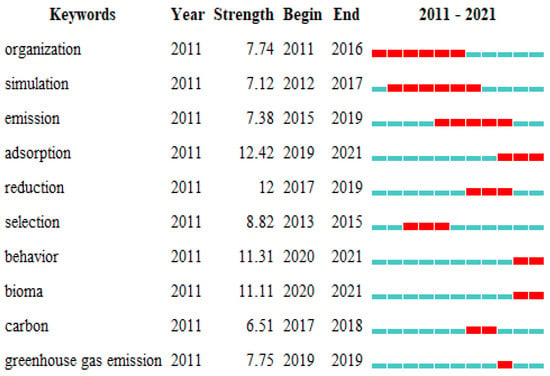
Figure 2.
Top ten keywords with the highest citation numbers in WOS.
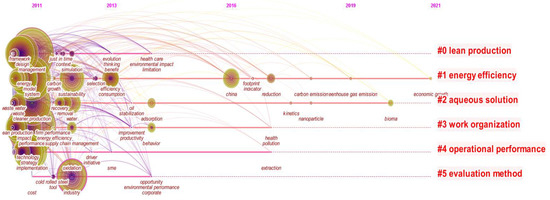
Figure 3.
Keyword timeline for the literature on cleaner production from WOS.

Table 5.
Keyword clustering table of the literature from WOS.
The cluster for lean production contains 32 nodes. The cluster average contour value (S) is 0.569 (when S > 0.5, this means the clustering is reliable). The average year of publication is 2011. The high-frequency terms for this cluster include lean production, contextual factor, green supply chain and food supply chain leanness. Other cluster labels and high-frequency terms are shown in Table 5.
4. Analysis Results of CNKI
4.1. Overview of Cleaner Production Studies from CNKI
Figure 4 shows that from 2011 to 2021, the number of studies on CP in CNKI shows an overall downward trend. It reached a peak in 2014 at 223. The number of published articles declined in 2012. The output, however, began to increase each year between 2012 and 2014. This may be related to the decision adopted by the Chinese Government to amend the Law of the People’s Republic of China on the Promotion of Cleaner Production (29 February 2012). The number of studies published began to decline again after 2014 and increased from 2019 to 2021. However, this was still less than the 223 published articles in 2014. Figure 4 also shows that after 2020, the literature in the field of CP increased.
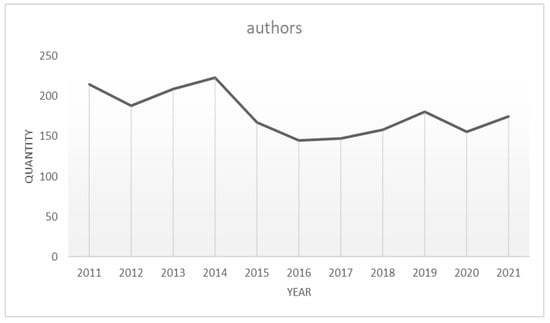
Figure 4.
Annual distribution of the studies on cleaner production from CNKI.
Regarding the discipline distribution of CP research in CNKI, Table 6 shows that environmental science and resource utilization are the main disciplines. Of the 1976 Chinese studies, 33.65% included related questions. In addition, 50% of the studies were related to industrial economy, macroeconomic management and sustainable development and agricultural economy. According to the proportion of studies published, the research on CP in China mostly focused on industry applications.

Table 6.
Topic distribution of studies on cleaner production from WOS (Top 10).
Table 7 list the 10 most cited articles from CNKI. These were concentrated between 2013 and 2014. Some scholars used mathematical models to study the factors that affect the introduction of CP in agricultural and industrial production, and subsequently made proposals based on the research output [24,25,26,27]. The prior literature indicates that some scholars have studied the construction of new management models within the ambit of CP [28,29], including the development of lean production [30], the development of green production in factories in various provinces of China [31], the development and application of the circular agriculture theory in China [32] and research on the emissions characteristics of VOCs in China [33].

Table 7.
Top 10 most highly cited studies on cleaner production from WOS.
4.2. Quantitative Analysis
4.2.1. Research Institutions
According to the number of studies published (Table 8), Huazhong Agricultural University has the largest number of articles of the Chinese research institutions. This is followed by Northwest University of Agriculture and Forestry Science and Technology. However, the central value of the research institutions is 0. This indicates that the research output on CP in China is dispersed.

Table 8.
The most cited articles on cleaner production from CNKI.
4.2.2. Research Hotspots
Table 9 shows the keyword frequency list for Chinese research studies, among which the keyword with the highest frequency is “cleaner production”. According to the clustering results, green development, lean production, circular economy, syngas low-carbon economy and so on are the topics studied by Chinese scholars. In terms of the frequency of keywords, the Chinese literature focuses on the methods related to CP.

Table 9.
Top 10 keywords related to cleaner production from CNKI.
Figure 5 shows the top 10 keywords related to cleaner production from 2011 to 2021. Synthesis gas, green production, green agriculture and environmental rules have been the frontier issues in CP in recent years. This to some extent reflects the development trend for the studies conducted so far. From Figure 5, the top three key words on CP in CNKI are green development, low-carbon economy and recycling economy, with scores of 16.31, 9.14 and 8.6, respectively. Synthesis gas, green production, green agriculture, environmental rules and other keywords are the prominent research topics in CNKI. In recent years, the research on CP in CNKI has focused on environmental regulation, green production and green agriculture. Among them, the strength of green development is significant but has decreased since 2016. However, regarding the sustained growth of synthesis gas, the strength is weak. This shows that scholars have been paying attention to this topic but have not focused on publishing related studies.
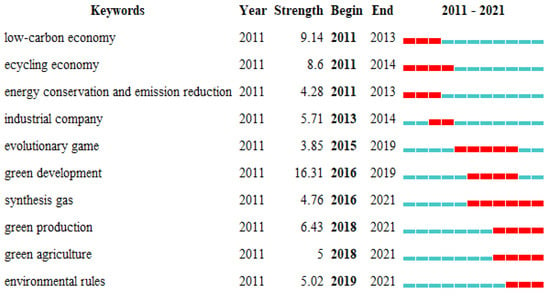
Figure 5.
Top ten keywords with the strongest citation in CNKI.
To further analyze the research hotspots in China, this study used the LLR algorithm to cluster the keywords to form 12 keyword clustering tags. Due to the large number of clustering tags generated, in this study we selected the first five tags (Table 10) for analysis. These were CP, influencing factors, green production, circular economy and syngas.

Table 10.
Keyword clustering for cleaner production studies in WOS.
The cluster for CP consists of 63 nodes. The average profile value S = 0.892, and the average year of publication is 2015. The high-frequency terms of the cluster include CP, energy savings and emission reductions, electroplating, end treatment and pollution prevention. Through the analysis, it was found that the research content focuses on three aspects. These are the study of the new model of CP [34,35], the realization path of CP [36] and the theory of CP [37]. The cluster for the influencing factors consists of 45 nodes (S = 0.921).
The average year of publication is 2015. The high-frequency terms of the cluster include the influencing factors, low-carbon economy, low-carbon agriculture, industrial enterprises, carbon emissions and so on. We found that these studies focus on the influencing factors of industrial green production [38,39] and agricultural green production [40,41,42]. The cluster for green production consists of 41 nodes, the average profile value (S value) of which is 0.987, while the average publishing year is 2019.
The high-frequency terms of the cluster include green production, green technology, biological pesticides, organic fertilizer and CP. The research focuses on the factors affecting the adoption of green manufacturing technology and the development of green production [43,44,45,46]. The cluster for the circular economy consists of 34 nodes (S = 0.898), while the average year of publication is 2014. The high-frequency terms of this cluster include circular economy, ecological civilization, green consumption, countermeasures and agriculture [47,48,49,50,51]. The cluster for syngas consists of 30 nodes (S = 0.994), and the average year of publication is 2016. The high-frequency terms of this cluster include syngas, light olefins, catalysts, light alcohols and Fischer–Tropsch synthesis. We found that the research focused on the realization path for syngas manufacturing catalysts [52,53,54,55].
5. Comparative Analysis Results
In this section, the studies from WOS and CNKI are compared in terms of the numbers of articles, research directions, research institutions and research hotspots. For the numbers of articles, Figure 6 shows that the quantity of researched articles in WOS is increasing year by year, while that of CNKI is decreasing. Before 2015, the number of studies published in CNKI was more than that in international studies. The trend however, changed afterwards. We can directly find the change in the research hotspot in one research field within a specific period. Since 2014, the research trend in the field of CP has been increased rapidly. Internationally, the number of studies on CP has increased significantly. The relevant research in CNKI is insufficient, and the number of studies has increased sharply. Overall, the number of international studies is significantly higher than that of CNKI.
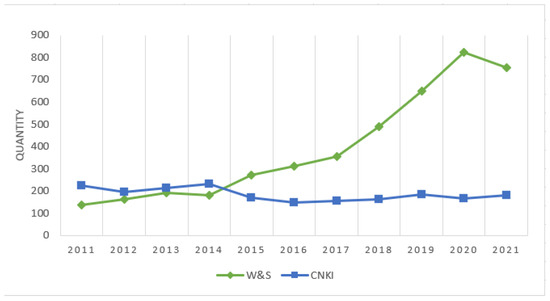
Figure 6.
Annual distribution of the studies on cleaner production from CNKI and WOS.
From Figure 7 and Figure 8, the keyword with the most frequent occurrence for international CP is “performance”. However, it is that “cleaner production” the most frequent in China. Specifically, the top keywords for international green production are performance (frequency is 436), management (332), impact (268), cleaner production (262), system (256), model (226), design (175), energy (156) and optimization (149). In CNKI, they are cleaner production (frequency 250), lean production (70), syngas (70), circular economy (60), green development (58), green production (53) and low-carbon economy (43). Overall, the international CP keywords are related to performance and management. This indicates that all countries pay more attention to organizational behavior, pollution prevention and environmental performance. The research in China focuses on CP, lean production, the circular economy and so on.
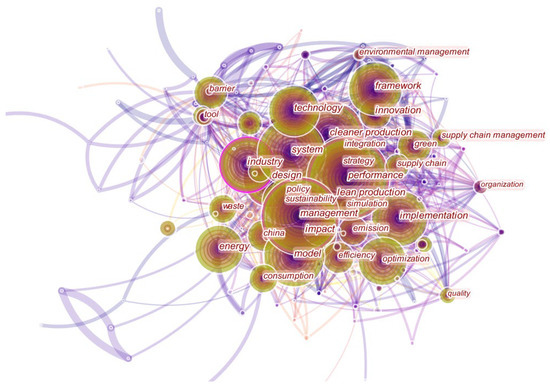
Figure 7.
Cluster view of keywords from WOS studies on cleaner production.
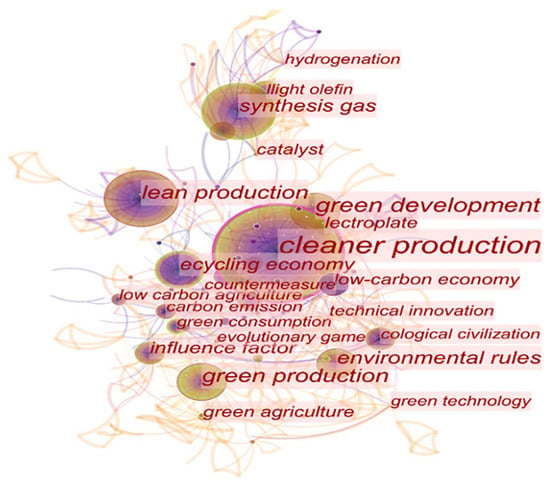
Figure 8.
Cluster view of keywords from CNKI studies on cleaner production.
CAS is the most influential research establishment of CP. The centrality of the Chinese Academy of Sciences is 0.11. This indicates that the international recognition and citations of the research results for this institution are high. However, the centrality of Huazhong Agricultural University is 0. This indicates that the research on CP at this institution is relatively scattered. In other words, the clustering effect has not been formed.
In terms of the research direction, the three main disciplines of WOS are engineering, environmental science and ecology. In contrast, 50% of the studies in CNKI explore CP from the perspectives of environmental science and resource utilization, industrial economics, agricultural economics, macro-economics and sustainable development.
6. Discussion
Through the collection of 4328 studies from WOS and 1976 Chinese studies (CNKI), this study used the bibliometric method to assess the research process, development process and future research trends related to CP. The difference between this study and the previous studies is mainly reflected in the systematic approaches adopted and the scope of coverage. Zhang et al. [56] analyzed the current situation regarding cleaner production in China, but did not comprehensively discuss the research on cleaner production. Hens et al. [1] discussed the evolution of cleaner production based on 37 documents. Letícia and Fernando [57] summarized the obstacles to the application of cleaner production practices. These studies are limited to one aspect of cleaner production, and do not comprehensively summarize the development of cleaner production.
In detail, this study analyzed the quantity of published articles, the distribution of the research disciplines, the research institutions and the keywords. The key research platforms, institutions, disciplines and topics highlighted in the field of CP were defined and comparatively analyzed using documents from the two databases, WOS and CNKI. Based on this, we have discussed the frontier issues of CP research and the prospects for future research. The key highlights of this paper are as follows:
- After 2014, the research on CP in the WOS gradually increased. From 2014 to 2021, the quantity of studies in the WOS increased from 181 to 756, with an average annual growth rate of 33.1%. This implies that the international attention on CP is increasing. On the other hand, our findings indicated that from 2011 to 2021, the quantity of articles published in CNKI declined. Moreover, from 2011 to 2014, more research studies were published in CNKI than in WOS. However, since then, the number of studies published in WOS has far exceeded that of CNKI. In 2021, the number of studies published by WOS was identified to be 756, while that of CNKI was found to be 182. Although the number of studies on CP in CNKI is relatively small, this does not mean that China pays less attention to CP. This is because Chinese institutions still account for 41.83% of the total literature in WOS. This shows that Chinese scholars pay a great deal of attention to the international academic platforms;
- CP involves many interdisciplinary studies. The main research objects of WOS are engineering, environmental sciences, ecology and sciences technology. The numbers of theses in these three disciplines equal 57.6%, 50.6% and 44.5% of the total, respectively. The literature from CNKI mainly comes from environmental science, resource utilization and industrial economics and agricultural economics disciplines. These account for 22.35%, 11.92% and 8.14% of the total papers published, respectively. The studies in WOS are more related to the micro-level, focusing on how to reduce pollution emissions through improvements in technology and modes of production to achieve CP. These scholars try to find concrete ways to solve the environmental problems encountered in industrial and agricultural production. On the other hand, the studies from CNKI are more inclined toward macro-research. Moreover, this study has established that the research perspectives in WOS and CNKI are different, but they complement each other;
- Most of the institutional affiliations of the authors from the two databases are highly reputed universities or research institutions. The publications and influence of the Chinese Academy of Sciences are top-ranked around the world. Tsinghua University also has many articles, but it is weak in terms of its research influence. There are more articles on research projects collaboratively carried out by authors from different research institutions in WOS. Many of the research studies in CNKI indicate less collaboration between authors across different universities or institutions. In addition, there is a lack of cooperation between different departments in the same institution. The highly cited studies from WOS and CNKI have been published in two journals, namely the Journal of Cleaner Production and Agricultural Resources and Regionalization in China, which are important scientific research journals for sustainable urbanization research. The Journal of Cleaner Production is an international, interdisciplinary magazine that focuses on the study and practice of CP. It has a great deal of influence among scholars. Thus, many highly cited and influential articles are published in this journal;
- The research focuses of the two databases are interrelated but somewhat different. The most common topics in WOS are lean production, energy efficiency, aqueous solutions, work organization, operational performance and the evaluation methods. However, the most common topics in CNKI are CP, influencing factors, green production, the circular economy and Syngas. Pollution prevention and control, energy savings and emission reductions in the production process were found to be issues of widespread concern around the world. Scholars from various countries are paying profound attention to the prevention and control of pollution, the improvement of the utilization rates of resources and the use of CP technology in the production process. However, there are some differences in the focuses of their research. The CP research in WOS focuses more on the improvement of the utilization rates of resources. For example, Silva [58] studied the impacts of cleaner production practices on large-scale textile manufacturing. On the other hand, the research topics in CNKI pay more attention to the improvement of the level of CP in society as a whole.
On the basis of these findings, this study analyzes the future prospects for international CP research and Chinese CP research as outlined below.
The future directions of international green production research mainly include the following aspects: (1) International cooperative research on CP, which needs to be further strengthened. At present, the objects of international CP research are mostly for a certain country or industry, and there are no transnational studies related to CP. However, the problem of CP contains strong externality factors. With the deepening of economic globalization, some pollutants will eventually spread to the atmosphere globally and will have serious negative impacts on various countries. Transnational research on CP will be an effective means to promote pollution control and green development. In the long run, international cooperation around CP will become the focus of further research. (2) The research on CP regarding the integration of multiple disciplines needs to be promoted urgently. The research results show that the international CP research achievements are generally concentrated in the fields of environmental science, engineering, technological innovation and so on. However, there is little research on CP from the perspective of the integration of different disciplines. With the further development of CP theories and methods, the research on CP will inevitably involve the intersection of multiple disciplines, especially the integration of economics, management, law, ecology and other disciplines. From a multi-disciplinary perspective to explore CP, an in-depth analysis of the related issues has important theoretical value and practical significance, but will also be conducive to bringing into full play the advantages of the discipline and will help to achieve theoretical innovation and technological breakthroughs.
The research on CP in China mainly focuses on two aspects, as follows: (1) The implementation path of CP needs to be further determined. Through this study, we found that the existing research lacks a systematic analysis of the implementation path of CP. In practice, the most popular high-frequency keywords are end-of-pipe treatment, human resource management and industrial ecology, with a lack of analysis of CP paths in China. In addition, the internal connections between each keyword are lacking in-depth investigations, and the tightness of each link in CP practice is not strong. Therefore, in the implementation path of CP, we should take note of to the top-level design practices and the integration of various links. (2) The mode of CP needs to be innovated urgently, especially the mode for multiple agents to participate in governance. Through this analysis, it can be found that most of the studies on CP in China come from enterprises and governments, including enterprise CP motivation, industrial technological innovation, environmental performance, enterprise policy and regulation and government taxation or subsidy studies. However, CP involves a variety of stakeholders, and their goals and interests will conflict; for example, there is a balance of interests among governments, enterprises and society. Therefore, in order to balance the multi-agent conflicts of interest, we must deeply study the system of multi-agent participation in governance, which is a potential research direction.
7. Conclusions and Limitations
Based on the analysis of the cleaner production literature from two databases using Citespace software, we have drawn the following conclusions: (1) The number of papers on cleaner production in WOS is growing rapidly, and is far greater than in CNKI. (2) The cleaner production research involves many interdisciplinary studies, and its research fields are very rich. (3) The research topics of the two databases are different but complementary. (4) WOS focuses on improving resource utilization. CNKI pays more attention to the improvement of the overall cleaner production level of the society.
The use of bibliometrics helps to improve the persuasiveness of a literature review and to understand the history of a research topic comprehensively and systematically within a field. Some scholars have used bibliometrics analyses to analyze the research results related to green production. They, however, focused on only one database. At present, there are no studies providing a comprehensive analysis of the research status of CP globally. Through the analysis of research institutions, countries and keywords in the field of CP, this study has identified the current research hotspots and future direction in the field of CP comprehensively and systematically. It provides a reference point for studies in the field of CP. Because Chinese scholars have great influence in this field, we analyzed the common points and differences between WOS and CNKI. Finally, in terms of the future research direction regarding bibliometrics, this study only used two authoritative databases in Chinese and English. However, studies in other countries such as Germany, France and Japan also have a strong influence in this field The authoritative databases of these countries can, therefore, be included in future studies to enhance the global outlook on CP publications.
Although we have provided meaningful research results, our research still has some limitations: (1) The selected databases are limited. We only selected two representative databases and did not include other databases. In future research, we could consider adding available archiving platforms and databases to make the research results more complete. (2) The keyword selection was not comprehensive enough, and similar subject words or keywords were not comprehensively analyzed after merging. (3) It is hoped that the future research can further analyze the literature on cleaner production in combination with the development of visual software tools, and can explore the research hotspots and development trends in this field.
Author Contributions
Conceptualization, Y.J., M.L. and A.D.; methodology, M.L. and A.D.; software, M.L. and A.D.; validation, X.L.; resources, M.L. and Y.J.; data curation, M.L. and Y.J.; writing—original draft preparation, M.L. and Y.J.; writing—review and editing, M.L. and E.M.A.; project administration, Y.J. All authors have read and agreed to the published version of the manuscript.
Funding
This research was financially supported by the Philosophy and Social Science Planning Project of Chengdu, grant number [YY2320200701]; the County Economy Research Center of Sichuan Province grant number [xy 2019014] and the Mineral Resources Research Center of Sichuan Province, grant number [SCKCZY2020-YB09]. The authors would like to express their gratitude for the usable answers provided by the survey respondents and the valuable comments from the anonymous reviewers.
Institutional Review Board Statement
Not applicable.
Informed Consent Statement
Not applicable.
Data Availability Statement
Not applicable.
Acknowledgments
We would like to thank Jie Zhang, Yingmei Hu and Maojun Cao for their insightful contribution that helped shape this paper. The authors express their gratitude to the anonymous reviewers and editors for their helpful comments about this paper.
Conflicts of Interest
The authors declare no conflict of interest.
References
- Hens, L.; Block, C.; Cabello-Eras, J.J.; Sagastume-Gutierez, A.; Garcia-Lorenz, D.; Chamorro, C.; Herrera Mendoza, K.; Haeseldonckx, D.; Vandecasteele, C. On the evolution of “cleaner production“ as a concept and a practice. J. Clean. Prod. 2018, 172, 3323–3333. [Google Scholar] [CrossRef]
- Jiang, Y.; Zhang, J.; Asante, D.; Yang, Y. Dynamic evaluation of low-carbon competitiveness(lcc) based on improved technique for order preference by similarity to an ideal solution (topsis) method: A case study of chinese steelworks. J. Clean. Prod. 2019, 217, 484–492. [Google Scholar] [CrossRef]
- Marodin, G.A.; Frank, A.G.; Tortorella, G.L.; Saurin, T.A. Contextual factors and lean production implementation in the Brazilian automotive supply chain. Supply Chain. Manag. 2016, 21, 417–432. [Google Scholar] [CrossRef]
- Cardoso, D.; Correia, J.F.; Silva, P.C.; Gaiola, D.; Lucato, W.C. Cleaner production in the textile industry and its relationship to sustainable development goals. J. Clean. Prod. 2019, 228, 1514–1525. [Google Scholar]
- Scheverin, V.N.; Fossati, A.; Horst, F.; Lassalle, V.; Jacobo, S. Magnetic hybrid gels for emulsified oil adsorption: An overview of their potential to solve environmental problems associated to petroleum spills. Environ. Sci. Pollut. Res. 2020, 27, 861–872. [Google Scholar] [CrossRef]
- Jiang, Y.; Hu, Y.; Asante, D.; Ampaw, E.M.; Asante, B. The Effects of Executives’low-carbon cognition on corporate low-carbon performance: A study of managerial discretion in China. J. Clean. Prod. 2022, 357, 132015. [Google Scholar] [CrossRef]
- Eder, P. Expert inquiry on innovation options for cleaner production in the chemical industry. J. Clean. Prod. 2003, 11, 347–364. [Google Scholar] [CrossRef]
- Gunarathne, N.; Sankalpani, U. Diffusion of cleaner production in a developing country: The case of sri lanka. J. Clean. Prod. 2021, 311, 127626. [Google Scholar] [CrossRef]
- Shi, L.; Qiang, Y. The review and perspective of cleaner production. China Popul. Resour. Environ. 2002, 12, 121–124. (In Chinese) [Google Scholar]
- Nasrin, K.; Susanna, D.; Weslynne, A.; Francisco, C. From cleaner production to sustainable development: The role of academia. J. Clean. Prod. 2015, 96, 30–43. [Google Scholar]
- Hoof, B.V.; Lyon, T.P. Cleaner production in small firms taking part in mexico’s sustainable supplier program. J. Clean. Prod. 2013, 41, 270–282. [Google Scholar] [CrossRef]
- Wang, Y.; Hang, Y.; Wang, Q.; Zhou, D.; Su, B. Cleaner production vs end-of-pipe treatment: Evidence from industrial so2 emissions abatement in China. J. Environ. Manag. 2021, 277, 111429. [Google Scholar]
- Jiang, Y.; Asante, D.; Zhang, J.; Cao, M. The effects of environmental factors on low-carbon innovation strategy: A study of the executive environmental leadership in China. J. Clean. Prod. 2020, 266, 121998. [Google Scholar] [CrossRef]
- Leite, R.; Amorim, M.; Rodrigues, M.; Neto, G.O. Overcoming barriers for adopting cleaner production: A case study in brazilian small metal-mechanic companies. Sustainability 2019, 11, 4808. [Google Scholar] [CrossRef] [Green Version]
- Neto, G.C.D.O.; Tucci, H.N.P.; Correia, J.M.F.; Silva, P.C.D.; Silva, V.H.C.D.; Ganga, C.M.D. Assessing the implementation of cleaner production and company sizes: Survey in textile companies. J. Eng. Fibers Fabr. 2020, 15, 55–59. [Google Scholar]
- Jiang, Y.; Asante, D.; Chen, D.; Zhang, J. Evaluation of low-carbon competitiveness based on a system evaluation method: A case study of three chinese steel companies. Math. Probl. Eng. 2021, 2021, 6664216. [Google Scholar]
- Wang, M.Y. The Meaning of Essencein “Clean Production”. China Popul. Mod. Law Sci. 2006, 28, 128–136. (In Chinese) [Google Scholar]
- Chen, C.B.; Chitose, A.; Kusadokoro, M.; Nie, H.S.; Xu, W.L.; Yang, F.F.; Yang, S. Sustainability and challenges in biodiesel production from waste cooking oil: An advanced bibliometric analysis. Energy Rep. 2021, 7, 4022–4034. [Google Scholar] [CrossRef]
- Azam, A.; Ahmed, A.; Wang, H.; Wang, Y.; Zhang, Z. Knowledge structure and research progress in wind power generation (wpg) from 2005 to 2020 using citespace based scientometric analysis. J. Clean. Prod. 2021, 295, 126496. [Google Scholar] [CrossRef]
- Zhong, S.; Chen, R.; Song, F.; Xu, Y. Knowledge mapping of carbon footprint research in a lca perspective: A visual analysis using citespace. Processes 2019, 7, 818. [Google Scholar] [CrossRef] [Green Version]
- Hu, W.; Li, C.H.; Ye, C.; Wang, J.; Deng, Y. Research progress on ecological models in the field of water eutrophication: Citespace analysis based on data from the ISI web of science database. Ecol. Model. 2019, 410, 108779. [Google Scholar] [CrossRef]
- Li, J.; Chen, C.M. Citespace: Scientific Text Mining and Visualization; Capital University of Economics and Business Press: Beijing, China, 2016. [Google Scholar]
- Ghisellini, P.; Cialani, C.; Ulgiati, S. A review on circular economy: The expected transition to a balanced interplay of environmental and economic systems. J. Clean. Prod. 2016, 114, 11–32. [Google Scholar] [CrossRef]
- Shen, N. Environmental efficiency, Industrial Heterogeneity and Intensity of Optimal Regulation—Nonlinear Test Based on Industrial Panel-data. China Ind. Econ. 2012, 3, 56–68. (In Chinese) [Google Scholar]
- Yang, Z. Ageing, social network and the adoption of green production technology: Evidence from farm households in six provinces in the yangtze river basin. China Rural. Surv. 2018, 4, 44–57. (In Chinese) [Google Scholar]
- Tian, Y.; Zhang, J.B.; He, K.; Feng, J.H. Analysis of farmers’ agricultural low-carbon production behavior and its influencing factors-Taking the application of chemical fertilizer and pesticide as an example. Rural. Obs. China 2015, 4, 61–70. (In Chinese) [Google Scholar]
- Ma, Q.Z.; Song, H.Q.; Chen, G.Y. A Study on Low-carbon product pricing and carbon emission problems under the Cap-and-Trade system. J. Ind. Eng. Eng. Manag. 2014, 28, 127–136. (In Chinese) [Google Scholar]
- LV, Y.W.; Ba, L.W. Empirical Research in Improving Quality Management Based on Lean Six Sigma. Sci. Technol. Manag. Res. 2014, 2, 226–232. (In Chinese) [Google Scholar]
- Niu, Z.W.; Jing, S.W. Discussion on management innovation mode of manufacturing enterprises based on lean production. J. Tianjin Univ. (Soc. Sci.) 2014, 16, 481–487. (In Chinese) [Google Scholar]
- Fan, D.C.; Hu, Y. Research review of lean thinking model. Manag. Mod. 2013, 4, 108–110. (In Chinese) [Google Scholar]
- Su, L.Y.; Zheng, H.X.; Wang, Y. Evaluation on green development of China’s Provincial Industry. China Popul. Resour. Environ. 2013, 23, 116–122. (In Chinese) [Google Scholar]
- Yin, C.B.; Zhou, Y.; Liu, L.H. Theory and practice of recycle agriculture in China. Chinese. J. Eco-Agric. 2013, 21, 47–53. (In Chinese) [Google Scholar]
- Wang, T.Y.; Li, Q.F.; LV, Y.L. Characteristics and countermeasures of volatile organic compounds (VOCs)emission in China. Environ. Sci. 2013, 34, 4756–4763. (In Chinese) [Google Scholar]
- Di, Q. Study of cleaner production assessment index system in urban. Environ. Eng. 2014, 5, 133–137. (In Chinese) [Google Scholar]
- Bai, S.W.; Zhang, J.S.; Wang, Z.; Wang, J.K. Clean feature modeling and evaluation technology for process design of cleaner production. Comput. Integr. Manuf. Syst. 2014, 20, 1572–1582. [Google Scholar]
- Gong, J.B.; Chen, M.Y.; Huang, C.; Qing, Y.J.; Yin, Q.X.; Wang, J.K. Clean production of pharmaceutical crystallization. CIESC J. 2015, 66, 3271–3278. (In Chinese) [Google Scholar]
- Zhou, C.B.; Li, Z.; Liu, Q.J.; Yu, H.J. Situation, problems and countermeasures of the cleaner production development in China. Environ. Prot. 2016, 44, 27–32. (In Chinese) [Google Scholar]
- Bi, K.X.; Yang, C.X.; Huang, P. Research on the Impact of FDI on the Green Process Innovation of Chinese Manufacturing Industries: An Empirical Analysis Based on the Panel Data. China Soft Sci. 2011, 9, 172–180. (In Chinese) [Google Scholar]
- Wang, X.L.; Wang, H.J.; Wu, L.H. Based on the LCA Method the Assessment and Promotion of Low Carbon Manufacturing in China’s Industry Enterprises: The Case of Liquor Enterprise. China Popul. Resour. Environ. 2014, 24, 74–81. (In Chinese) [Google Scholar]
- Chen, R.; Jiang, Z.D. Evaluation on the low carbon agricultural development performance and policy in China. J. S. China Agric. Univ. (Soc. Sci. Ed.) 2017, 16, 28–40. (In Chinese) [Google Scholar]
- Zhao, X.Y.; Zhao, J.; Zhang, M.Y. Study on the Preference of Tea Farmers’ Biological Pesticides and Willingness to Pay: An Empirical Analysis Based on Selection Experiment. Tech. Economy 2020, 39, 103–111. (In Chinese) [Google Scholar]
- Zhang, X.H.; Tang, X.Q. Green production behavior of participants in agricultural industrialization consortium: From the perspective of government incentive. J. Agro-For. Econ. Manag. 2021, 20, 187–198. (In Chinese) [Google Scholar]
- Zhao, X.Y.; Zheng, J.; Zhang, M.Y.; LI, H.H. Mechanism of green production decision-making under the improved theory of planned behavior framework for new agrarian business entities. Chin. J. Eco-Agric. 2021, 29, 1636–1648. (In Chinese) [Google Scholar]
- Shen, X.X.; Duan, J.Y.; Zhu, S.Y. Exploring research on socialized vices patterns for green agricultural production. Chin. J. Agric. Resour. Reg. Plan. 2020, 41, 15–20. (In Chinese) [Google Scholar]
- Luo, L.; Liu, Y.C.; Ma, S.; Li, H.; Yang, X.F. Government regulations, market revenue incentives and farmers’ adoption of green production technology. Sci. Technol. Manag. Res 2021, 15, 178–183. (In Chinese) [Google Scholar]
- Hou, M.C.; Chen, H.; Long, R.Y. Research progress and prospect of green product of green production: Based on bibliometric analysis. Syst. Eng. -Theory Pract. 2020, 40, 2104–2115. (In Chinese) [Google Scholar]
- Zhao, G.D. The development of venous industry under the background of recycling economy: Mode transformation or sustainability. Reform 2011, 2, 35–40. (In Chinese) [Google Scholar]
- Ma, S.; Wang, Z. Research on green development index of the Yangtze River economic belt. Shanghai Economy 2019, 5, 42–53. (In Chinese) [Google Scholar]
- Xiang, S.J.; Zheng, R.K. Study on the Green Economy Development Index in China. Stat. Res. 2013, 30, 72–77. (In Chinese) [Google Scholar]
- Qian, Y. To realize ecological priority and green development. Res. Environ. Sci. 2020, 33, 1069–1074. (In Chinese) [Google Scholar]
- Zhang, Z.Q.; Chen, N. Evaluation of ecological civilization construction in provincial capital cities in the Yellow River Basin. Qinghai Soc. Sci. 2021, 4, 36–45. (In Chinese) [Google Scholar]
- Wang, Q.J.; Shang, Y.S.; Xu, D.P.; Xing, A.H. Research progress in OX-ZEO catalysts for single-step synthesis of light olefins from syngas. Nat. Gas Chem. Ind. 2020, 45, 121–134. (In Chinese) [Google Scholar]
- Zhao, G.L.; Liu, C.; Xing, X.X.; Wang, J.S.; Liu, S.; Zhang, X.F. Latest progress in one-step conversion from syngas to light olefins. Mod. Chem. Ind. 2019, 2, 55–60. [Google Scholar]
- Ma, G.Y.; Xu, Y.F.; Wang, J.; Wang, Q.; Zheng, R.G.; Ding, M.Y. Research progress of iron-based catalyst for converting syngas directly to light olefins. Chem. Ind. Eng. Prog. 2018, 37, 992–1000. (In Chinese) [Google Scholar]
- Yao, C.L.; Quan, H.; Zhang, Z.Q. Hydrogenation of medium and low temperature coal tars for production of clean fuel oil. Chem. Ind. Eng. Prog. 2013, 32, 501–507. (In Chinese) [Google Scholar]
- Zhang, X.L.; Yu, H.B.; Cai, M.; Lv, Z.L. Cleaner Production in China. Green Economy 2012, 8, 46–48, 66. (In Chinese) [Google Scholar]
- Letícia, C.V.; Fernando, G.A. Barriers and strategies applying Cleaner Production: A Systematic Review. J. Clean. Prod. 2015, 113, 5–16. [Google Scholar]
- Silva, P.; Neto, G.; Correia, J.; Tucci, H. Evaluation of economic, environmental and operational performance of the adoption of cleaner production: Survey in large textile industries. J. Clean. Prod. 2020, 278, 123855. [Google Scholar] [CrossRef]
Publisher’s Note: MDPI stays neutral with regard to jurisdictional claims in published maps and institutional affiliations. |
© 2022 by the authors. Licensee MDPI, Basel, Switzerland. This article is an open access article distributed under the terms and conditions of the Creative Commons Attribution (CC BY) license (https://creativecommons.org/licenses/by/4.0/).